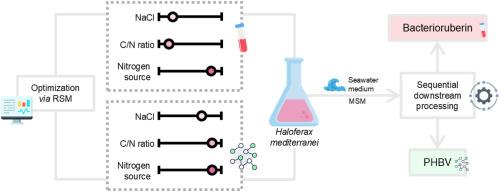盐化或不盐化:以地中海卤黄为原料,优化聚(3-羟基丁酸酯-co-3-羟基戊酸酯)和菌脲的生产和顺序下游加工
IF 5.8
2区 化学
Q2 CHEMISTRY, MULTIDISCIPLINARY
引用次数: 0
摘要
本文研究了一种从地中海嗜盐古菌中可持续生产和同时回收两种高价值生物产品聚(3-羟基丁酸酯-co-3-羟戊酸酯)(PHBV)和细菌绿杆菌素(BR)的集成生物工艺。采用响应面法对发酵关键参数(NaCl浓度、碳氮比、氮源)进行优化。对最低合成介质和海水进行了评估,后者显示出作为淡水栽培系统的更可持续替代品的潜力。在高盐度(167.7 g L−1 NaCl)、C/N比为40、以KNO3为氮源的条件下,PHBV积累量达到最佳(25% gpolymer/gCDW)。相比之下,中等盐度(100 g L−1)和较低C/N比(8)下BR产量最大(7.8 mg L-1)。为了实现高效的产品分离,开发了一种顺序下游策略,使PHBV和BR的回收率与传统的单产品提取方案相当,同时减少了对卤化溶剂的依赖。总的来说,提议的过程通过一个资源高效的平台支持嗜盐生物质的增值,有助于发展符合绿色和可持续化学原则的综合生物炼制方法。本文章由计算机程序翻译,如有差异,请以英文原文为准。

To salt or not to salt: Optimized production and sequential downstream processing of poly(3-hydroxybutyrate-co-3-hydroxyvalerate) and bacterioruberin from Haloferax mediterranei
This study presents an integrated bioprocess for the sustainable production and simultaneous recovery of two high-value bioproducts – poly(3-hydroxybutyrate-co-3-hydroxyvalerate) (PHBV) and bacterioruberin (BR) – from the halophilic archaeon Haloferax mediterranei. A Response Surface Methodology was applied to optimize key fermentation parameters, such as NaCl concentration, carbon-to-nitrogen (C/N) ratio, and nitrogen source. Both minimal synthetic medium and seawater were assessed, the latter demonstrating potential as a more sustainable alternative to freshwater-based cultivation systems. Optimal PHBV accumulation (25 % gpolymer/gCDW) was achieved under high salinity (167.7 g L−1 NaCl), a C/N ratio of 40, and with KNO3 as the nitrogen source. In contrast, BR production was maximized (7.8 mg L-1) under moderate salinity (100 g L−1) and a lower C/N ratio (8). To enable efficient product separation, a sequential downstream strategy was developed, allowing recovery yields of PHBV and BR comparable to conventional single-product extraction protocols, while reducing reliance on halogenated solvents. Overall, the proposed process supports the valorization of halophilic biomass through a resource-efficient platform, contributing to the development of integrated biorefinery approaches aligned with principles of green and sustainable chemistry.
求助全文
通过发布文献求助,成功后即可免费获取论文全文。
去求助
来源期刊

Sustainable Chemistry and Pharmacy
Environmental Science-Pollution
CiteScore
8.20
自引率
6.70%
发文量
274
审稿时长
37 days
期刊介绍:
Sustainable Chemistry and Pharmacy publishes research that is related to chemistry, pharmacy and sustainability science in a forward oriented manner. It provides a unique forum for the publication of innovative research on the intersection and overlap of chemistry and pharmacy on the one hand and sustainability on the other hand. This includes contributions related to increasing sustainability of chemistry and pharmaceutical science and industries itself as well as their products in relation to the contribution of these to sustainability itself. As an interdisciplinary and transdisciplinary journal it addresses all sustainability related issues along the life cycle of chemical and pharmaceutical products form resource related topics until the end of life of products. This includes not only natural science based approaches and issues but also from humanities, social science and economics as far as they are dealing with sustainability related to chemistry and pharmacy. Sustainable Chemistry and Pharmacy aims at bridging between disciplines as well as developing and developed countries.
 求助内容:
求助内容: 应助结果提醒方式:
应助结果提醒方式:


